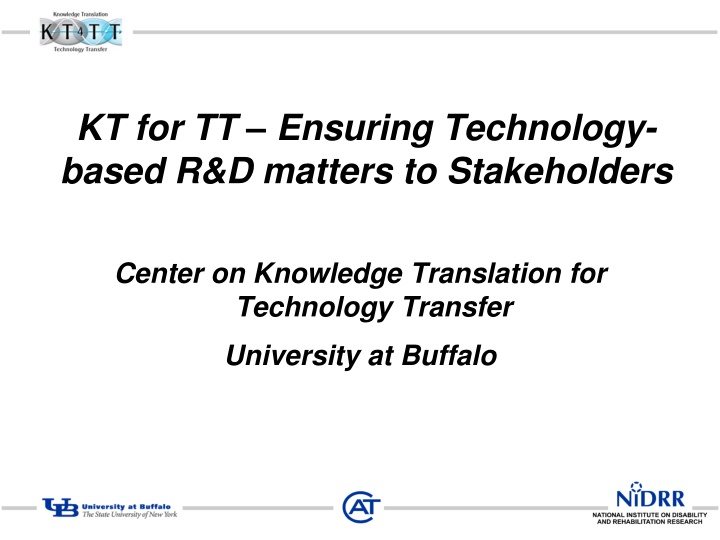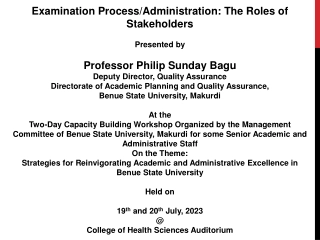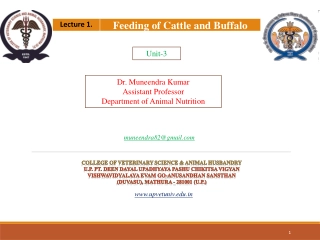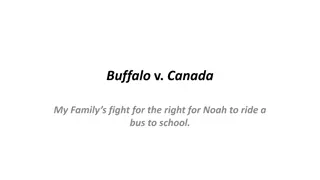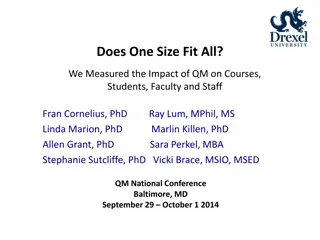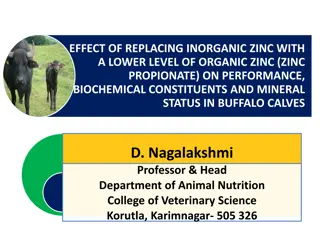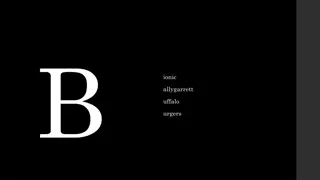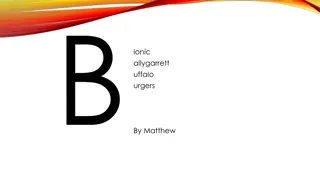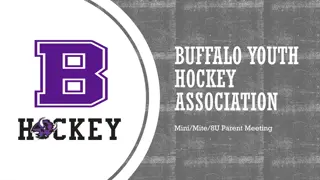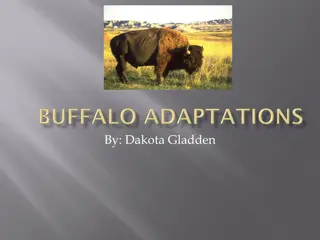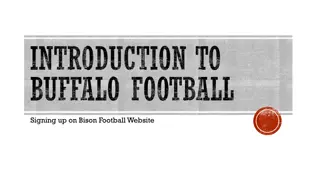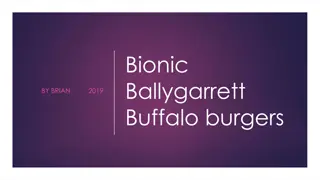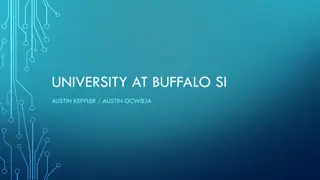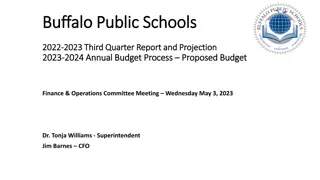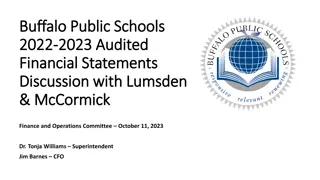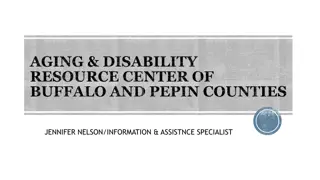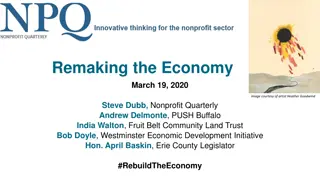Ensuring Technology-based R&D Matters to Stakeholders & University at Buffalo
Convergence of science & technology, mission for quality of life, assistive technology, academic vs. industry R&D, models & methods for knowledge translation in technology transfer.
Download Presentation

Please find below an Image/Link to download the presentation.
The content on the website is provided AS IS for your information and personal use only. It may not be sold, licensed, or shared on other websites without obtaining consent from the author.If you encounter any issues during the download, it is possible that the publisher has removed the file from their server.
You are allowed to download the files provided on this website for personal or commercial use, subject to the condition that they are used lawfully. All files are the property of their respective owners.
The content on the website is provided AS IS for your information and personal use only. It may not be sold, licensed, or shared on other websites without obtaining consent from the author.
E N D
Presentation Transcript
KT for TT Ensuring Technology- based R&D matters to Stakeholders Center on Knowledge Translation for Technology Transfer University at Buffalo
Session Objectives 1. Define KT and describe how Models, Methods and Measures differ from traditional Dissemination and Diffusion Strategies 2. Present parallels between KT for research projects and KT for development projects; and explain how they link to move from conceptual idea to tangible product. 3. Present KT for TT Model and its relevance to Stakeholders particularly intermediaries.
Background Convergence of Science and Technology - Technology, Medicine & Rehabilitation (Medical Model) Federal Funding for Basic Research to generate repository of science-based knowledge. Convergence of Science and Society Empowerment & Independent Living (Social Model) Federal Funding for Applied Research to generate prototype technologies with product potential.
Background (cont.) Mission of NIDRR/USDE Quality of life for people with disabilities through new knowledge and new products. Assistive Technology Defined AT as a class of Devices and Services to benefit PWD s. Generate Knowledge from Research and Products from Development all to improve quality of life for persons with disabilities.
Three Confounds Academic vs. Industry R&D Scholarly vs. Commercial Product Supply Push vs. Demand Pull Innovation
Academic R&D - Research and Dissemination Scientific Method Systematic Process. Symbiotic Closed System of Scholars and Publishers. Knowledge Producers know market requirements (Author guidelines & peer review). Success defined as contributions to Global Knowledge Base, evidenced via citations.
Industry R&D - Product Development and Testing PDMA Method - Systematic Process Competitive and Open System of Entrepreneurs, Corporations and Markets. User requirements and constraints are ill-defined and opportunities are dynamic. Success defined as sales and market share, evidenced by sales and growth.
Keys to Confounds Know your Goal - Final product/service innovation. Know your Role In R/D/P continuum from concept to marketplace. Know your Customer Motivations in context of Stakeholder Value Chain.
Research leads to Development, which leads to Products RDP Model Input -> Output -> Outcome -> Impact Research output becomes Development input; Development output becomes Production input; Product outcomes impact Target Populations.
What is Knowledge Translation? A method for moving academic knowledge into stakeholder action. Definition Canadian Institutes for Health Research Origins Evidence-based Medicine to justify Federal & Public investment. Current models focus on supply push.
Analogies between KT and TT End of Grant KT = Supply Push TT Applying discovery from basic inquiry (Mode 1 science). Integrated KT = Demand Pull TT Creating discovery from validated need (Mode 2 science). Science has rigor = Industry has relevance. The RDP Model requires both rigor and relevance to optimize chance of success.
Process Stages and Gates Stage 1: Discovery Research GATE 1: Idea Screen Stage 2: Scoping GATE 2: Second Screen Stage 3: Conduct Research and Generate Idea GATE 3: Go to Build Business Case? Development Stage 4: Build Business Case and Development Planning GATE 4: Go to Development? Stage 5: Implement Development Plan GATE 5: Go to Testing? Stage 6: Testing and Validation GATE 6: Go to Production Planning? Stage 7: Production Planning and Preparation Production GATE 7: Go to Launch? Stage 8: Launch GATE 8: Post Production Assessment Stage 9: Post-Launch Review
Process Stages Steps Stage 1: Discovery Assess Users Needs / Identify Problem Propose Plausible Solutions GATE 1: Idea Screen Stage 2: Scoping Define Concept Perform Preliminary Assessments (Innovation Screen) Research GATE 2: Secondary Screen Stage 3: Conduct Research and Generate Idea Identify Specific Knowledge Gaps Conduct Appropriate Knowledge Inquiries Compile Findings Propose Components Conceptualize Model/Draft Solution Evaluate Research Findings
Process Stages Steps GATE 3: Go to Build Business Case? Stage 4: Build Business Case and Development Planning Build Business Case Implement IP Strategy Initiate Key Co-Development Practices Develop Implementation Plan Allocate Adequate Resources Gather, Analyze and Prioritize Customer Needs Identify Product Features and Specifications Development GATE 4: Go to Development? Stage 5: Implement Development Plan Build Alpha Prototype Models Test Alpha Prototype Models Refine Models GATE 5: Go to Testing? Stage 6: Testing and Validation Test Beta Prototype with Consumers In Lab Refine Beta Prototype Models Test Beta Prototype with Consumers In Field
Process Stages Steps GATE 6: Go to Production Planning? Stage 7: Production Planning and Preparation Refine Beta Prototype Models Further Draft Preliminary Bill of Materials Develop Materials Plan Develop Production and Capacity Plan Plan and Schedule Engineering Plan and Schedule Tool and Process Design Estimate Costs Using Preliminary Bill of Materials Review IP Protection Finalize Marketing and Sales Activities Finalize Distribution Logistics Initiate Trial or Limited Production Runs Test Market or Trial Sell Production GATE 7: Go to Launch? Stage 8: Launch GATE 8: Post Production Assessment Stage 9: Post-Launch Review Launch Product and Provide Product Support Monitor Fix Review Performance Against Expectations
KT for TT Implications of RDP Model Technology-oriented research projects must consider downstream development and production the goal. The expected knowledge output must demonstrate validated innovativeness: Novelty in marketplace. Feasibility in design. Utility to function. Principal must define goals and roles.
Where to go from here What should government change? Model and Method for linking Research and Development to generate Product Outcomes. Why should it change? Evidence shows a different approach works better. Why is government following current approach? R&D implementation in 1940 s led by academics.
Where to go from here (cont.) KT is academia s approach to applying good business marketing practices. Not sufficient must go full measure of implementing RDP Model to achieve desired outcomes from R&D to make R&D matter!
KT4TT Program Sponsored by NIDRR to increase application of technology-related grantee R&D outputs. Experiment in small field with large implications. Cross-walk TT to KT, and link KT to TT, demonstrate and test KT4TT model. Validate model in context of prior research as well as context of new grantee practices. Establish best practices for Steps & Tasks.
Role of KT4TT Program Apply what we know about TT and KT to create an operational model of KT4TT. Begin with end in mind both models lead to application and use. Generate evidence from research to speak to academic values. Generate evidence from development to speak to industry values. Link both forms of evidence to change funding and evaluation of government grant programs.
TT and KT Resources Materials on the following slides are useful to all Stakeholders involved in the Research, Development, Production continuum. Project website under construction will contain all relevant resources: kt4tt.buffalo.edu
TT Resources How to guides T2RERC Training modules Supply push, demand pull, primary and secondary market research, intellectual property, commercialization, and evaluation Technology Transfer Tactics Best practices Free e-zine
TT Resources Associations and Organizations Association of University Technology Managers Intellectual Property Owners Association Advanced Medical Technology Association Licensing Executives Society
TT Resources Market Research Resources General Disability Statistics Specific Disability Statistics Trends Competing Products Abledata Competing Technology USPTO
General Disability Statistics International Disability Statistics World Health Organization- Disability U.S. and Regional Disability Statistics Census Bureau Disability
Disability-Specific Resources National Institute of Health (NIH) T2RERC Publications Industry Profile on Vision Technologies Industry Profile on Educational Technologies Industry Profile on Wheeled Mobility Coming Soon! Advocacy Organizations American Foundation for the Blind National Federation of the Blind Administration on Aging
Understanding Trends and Market Growth Longitudinal National Surveys National Health Interview Survey (annual) Activity limitations, instrumental activities of daily living, work limitations; vision, hearing, and mobility limitations; learning disabilities in children; insurance coverage; standard demographics (age, income, race, etc.) Current Population Survey (monthly) Income, employment, occupation, industry; work disability; standard demographics American Community Survey (annual) Income, age, housing, journey to work; hearing, vision, and cognitive limitations; standard demographics Survey of Income and Program Participation (continuous) Labor force, program participation and eligibility; disability; standard demographics
KT Resources National Center for the Dissemination of Disability Research Focus Technical Brief Webcasts KT Library Articles Guidelines Models Organizations Research Registries
KT Resources Agency for Healthcare Research and Quality Innovations Exchange Canadian Institutes of Health Research Definitions; Strategies; News. Canadian Health Services Research Foundation Resources & Tools Acquisition, Assessment, Adaptation, and Application
Acknowledgement This is a presentation of the Center on Knowledge Translation for Technology Transfer, which is funded by the National Institute on Disability and Rehabilitation Research of the U.S. Department of Education under grant number H133A080050. The opinions contained in this presentation are those of the grantee and do not necessarily reflect those of the U.S. Department of Education.
